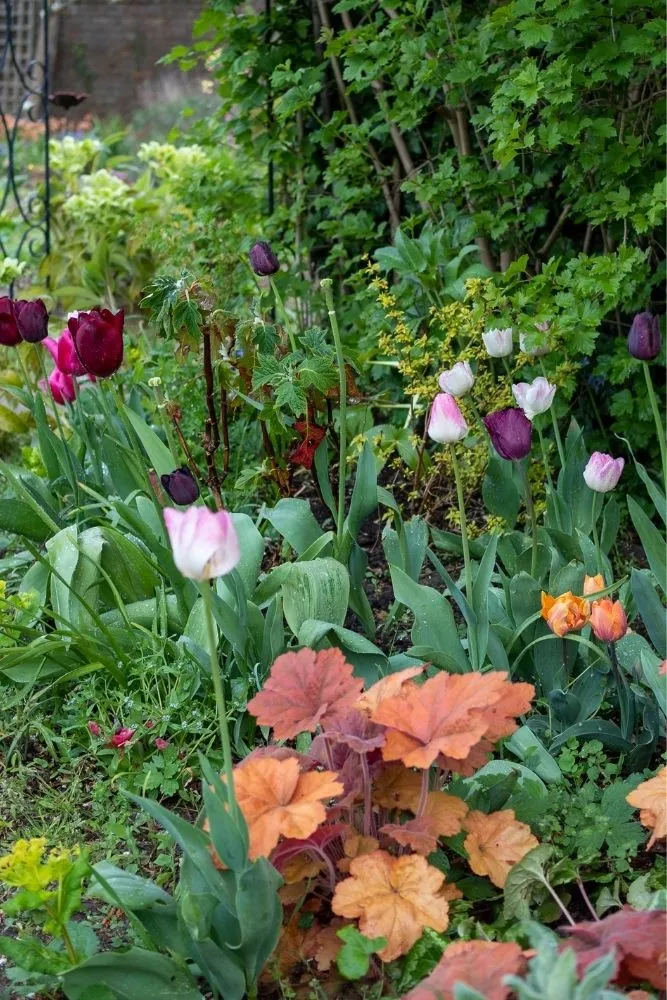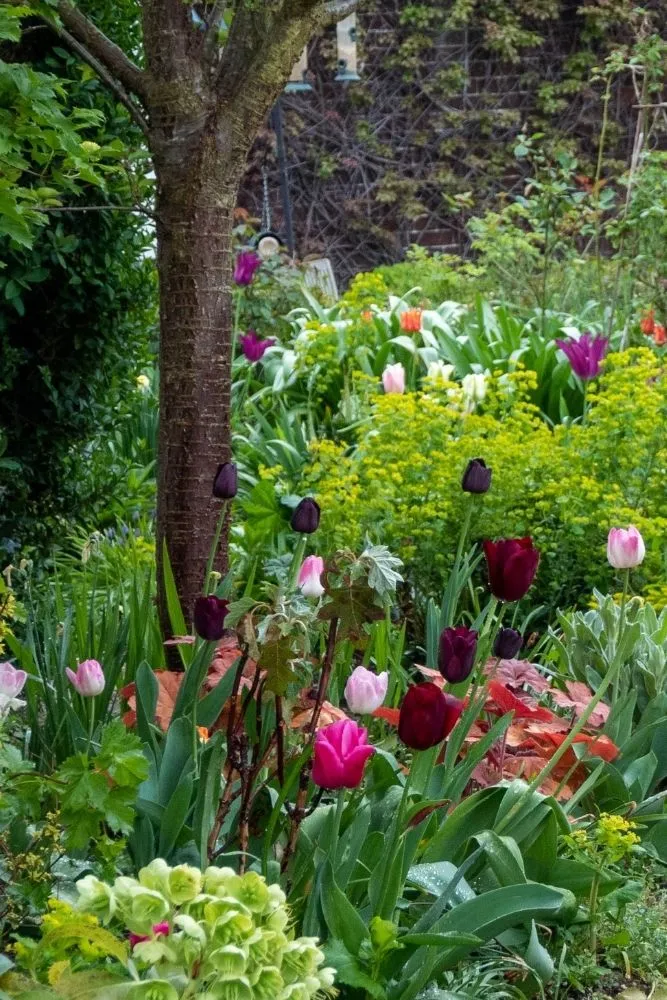Here are answers to the 5 most common spring gardening questions.
I prefer not to specify a month, because the trouble with ‘Gardening tips for April (or whatever month)’ is that your April and my April may be very different, even if we are both in the UK. I live quite near to the North Kent coast and my daffodils are over by the beginning of April. Yet just an hour away, in Dan Cooper’s garden, the bulbs are just coming into their full glory.
I’m hoping to photograph them for next week’s blog post, and am panicking that they will be over. Dan, however, says they haven’t quite got to their best yet.
And that’s only an hour away. It will be different still in Wales, Cornwall, the north of Scotland, the Lake District and more.
But if we are temperate gardeners (in North America, Northern Europe, the southern tip of Australia and New Zealand…), we grow bulbs and have fruit tree blossom in spring. And we have many of the same spring gardening questions.
What to do after daffodils and tulips have flowered
Snip off the dead heads of the flowers as they go over. That means they will concentrate all their efforts on creating next years flowers in the bulb.
Many gardeners also recommend adding a liquid feed at this point. If you mulch your soil regularly it should be quite fertile already, but extra fertiliser does lead to more flowers, so I think this is a question of personal preference. I’ve used Envii and Maxicrop in the past. Both are good.
If you have a very dry spring, then water your bulbs from about three weeks before flowering to a few weeks afterwards. That will help next year’s flowers.
The other thing you should do – every 3-4 years – is to dig up over-crowded clumps of daffodils. Divide them up and replant some of them where they were and some elsewhere.
This means more daffodils for free and it also helps stop daffodils going ‘blind’ or not flowering.
We all now know that tie-ing up daffodil foliage is damaging and means fewer flowers next year. Leave the leaves to go brown and die back naturally.
Which tulips can be left in the ground?
This must be one of the most common spring gardening questions. Daffodils and snowdrops often spread and multiply.
But tulips are much more variable. Often you’ll plant a clump of tulips, but three years later, there is just a single bloom waving at you.
The trouble with this, in my garden anyway, is that there are single tulips in different colours dotted apparently randomly around the garden. They are leftovers from previous colour-coordinated clumps.
There are two factors. One is the variety of tulip. It’s generally agreed that a few tulips, such as ‘Ballerina’ and ‘Spring Green’, are good at coming back year after year.
The other tip is to plant your tulips very deep. When I attended a Sarah Raven workshop, she advised us to plant our tulips 12″ deep, which is far deeper than you would ever see on the packet.
I did this with ‘Ballerina’ and she has been coming back for 15 years.
Tulip planting mistakes
Now that the tulips are out, I can see that I’ve made that number one tulip planting mistake. That’s failing to remember the heights of different varieties when you plant tulip bulbs.
I bought some Tulip ‘Princess Irene’ and they’re supposed to be 30cm high. But I’ve planted them in the middle of the border, and the taller tulips on the outside.

The other major tulip planting mistake is to plant too early. While it’s fine to plant daffodils in autumn, tulips are better planted in winter, provided that you don’t have snow and ice. (If you do, just plant as late into autumn as you can).
Why are my tulips so short?
This is one of the most asked spring gardening questions this year. And that’s because we’ve had another really dry spring.
Generally my tulips are shorter this year than in the past and princess Irene is definitely supposed to be taller. If you want your tulips to have maximum size and performance, then water them about 3 weeks before they’re about to flower.
I actually tested this out (unintentionally). I watered my tulips in pots this year, but I didn’t water any of the tulips I’d planted in the border.
Last winter, I planted groups of Princess Irene both in pots and in the borders. The Princess Irene in the pot was watered weekly from about one month before flowering. She has grown to her full height, ranging from 25cm-30cm.
But Princess Irene in the border is short and stubby. The heights range from 15cm-23cm. They’re exactly the same tulip, bought and planted at the same time, from the same supplier.
It’s also noticeable that the tulips I planted deeply – the Ballerina tulips – are full height too. It may be that they’ve been able to access moisture in the soil deep down.
When should I dig my garden in spring?
If you are a regular reader, you will know that I don’t ever dig my garden – in spring or at any other time.
The traditional advice – and you will still find it on many sites – is to dig over your garden in spring, incorporating lots of organic matter.
However, like an increasing number of people today, I am a no dig/no till gardener, so I suggest you don’t dig your garden at all, not even in spring.
Instead of digging in the organic matter (garden or local authority compost, well rotted manure, Strulch), lay it on top. The worms and the micro-organisms will work it in naturally.
Sometimes people say that they have to dig, because they have very heavy clay soil. However, the method also works for heavier and lighter soils. If you are in doubt, why not set aside one border as ‘no dig/no till’ and see how it goes.
How do I prevent weeds in spring?
You can’t abolish weeds entirely, even if you have weed suppressant membrane, artificial grass, concrete or the fiercest weed-killing sprays.
Weed seeds float in on the wind. Their roots smuggle themselves in on other plants or under fences and walls. Weeds are amazing survivors.
But if you add a layer of mulch on top of your borders, you will prevent some annual weed seeds from germinating, so mulching is your number one way of preventing weeds. Last year, I bought a straw-based mulch product called Strulch, which I found effective on my veg beds. Several friends have also found it good.
Your number one strategy is to do lots of weeding in spring, because if you weed early on, there will be fewer weeds later on in the year.
When should I fertilise my garden in spring?
This question also relates back to the issue of mulching. If you mulch your borders with something biodegradable, such as garden compost, then you are feeding your soil. It will help all your plants grow better.
But fertiliser only helps specific plants. It doesn’t improve the soil. You will see advice to scatter an all-purpose fertiliser over your borders in spring, and that will help fertilise the plants near it.
However, if you mulch your soil regularly, you only need to fertilise the plants that really need extra.
And number one amongst those is roses. If your roses aren’t flowering or have yellowing leaves, they need more nutrition. Neil Miller, head gardener at Hever Castle, where they have 4000 roses suggests feeding roses with a slow release fertiliser. Feed once in early spring and once in late summer.
In the past, I’ve bought David Austin Organic Rose Feed and have also used Vitax Organic Rose Feed and Toprose. They’re all slow release fertilisers, so you only need the two applications a year. If you use a liquid seaweed feed or some other fertilisers, you will need to feed weekly or fortnightly (check the instructions.)
If you don’t have a specific rose fertiliser, it’s better to use an all purpose fertiliser rather than not to fertilise at all.
If you grow vegetables, they also need fertilising, but that is usually done as they are coming up to harvest rather than in spring when they are just beginning to grow.

Leave a Reply